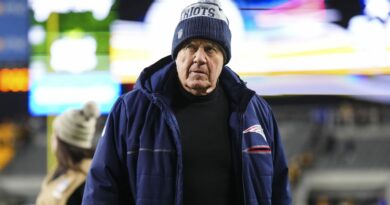Gil Brandt dies at 91: Godfather of modern scouting helped build Dallas Cowboys into 'America's Team'
The irony is that Gil Brandt wasn’t much of a football player himself.
Brandt, who died Thursday at age 91, was a 150-pound defensive back at his Milwaukee high school, but that is where his playing days ended, only two years before his formal education at the University of Wisconsin ended, too.
But Brandt knew football — more specifically, what made good football players, how to evaluate them and how they could fit into a roster. He knew all of that so well that he became not only one of the preeminent talent evaluators of his era while building the Dallas Cowboys team that won two Super Bowls in the 1970s, but also the godfather of modern scouting and the use of data in personnel evaluation.
“We are so deeply saddened by the passing of Gil Brandt — a true icon and pioneer of our sport,” Cowboys owner Jerry Jones said in a statement released on Thursday. “Gil was at the very core of the early success of the Dallas Cowboys and continued to serve as a great ambassador for the organization for decades beyond that. His contributions cemented his spot in the Ring of Honor. He was my friend and a mentor not only to me, but to countless executives, coaches, players and broadcasters across the National Football League.
“His dedication to, and passion for, this game left a lasting impact on generations of Hall of Fame players and coaches. There are very few people that have been able to have the kind of generational impact that he did.”
Brandt’s reputation as vice president of player personnel in Dallas was that he knew everything about everybody — height, weight, 40 times, girlfriends, eating habits. It was knowledge he continued to dispense in his post-Cowboys years as an analyst for NFL.com and on his SiriusXM NFL Radio show. On the receiving end was anybody who wanted to know the goods: scouts, general managers, coaches, media members. Brandt trafficked in information, surely, but most of all, he was in the business of relationships. He visited coaches even when they didn’t have draftable players. He remembered to ask about people’s children. His elegant Christmas cards arrived every year for hundreds of recipients.
“One of the stories they liked to tell from the Cowboys days was that some fairly obscure player name came up, and Gil said, ‘His father sells eggs in Albuquerque,’ ” recalled Greg Aiello, the NFL’s former public relations executive who worked with Brandt in Dallas.
Aiello thought of that story — and many more like it — when the NFL was preparing to launch its website right before the 1995 draft and was in need of an analyst. Aiello told his colleagues at the NFL’s league office that he knew a person who knew a lot about the draft. That was an understatement.
Brandt worked for the Cowboys from their inception in 1960 to 1989, when Jones bought the team and hired his own people. During that three-decade span, Brandt was part of a triumvirate — along with head coach Tom Landry and team president/general manager Tex Schramm — that built “America’s Team,” assembling a roster that included QB Roger Staubach, RB Tony Dorsett, WR Drew Pearson, DB Mel Renfro and many more illustrious names. Even though Brandt was fired a week after the ’89 draft, many of the techniques he helped pioneer in player evaluation are still in use throughout the league, in some cases more than a half-century after Brandt and the Cowboys first tried them. Using computers for scouting and evaluation? Brandt did that. Finding prospects at small schools and in other sports? Brandt did that. He used psychological testing in evaluation, developed a scouting system that spread to other teams and helped to create the NFL Scouting Combine which continues to be the epicenter of the pre-draft evaluation process.
“Looking at Gil Brandt and the job that he did with the personnel, he certainly should be in the Hall of Fame based on his contributions to this game and contributions to the personnel and scouting side of it,” New England Patriots coach Bill Belichick said in 2017. “He’d probably be the first guy I would put in there.”
Brandt was elected to the Pro Football Hall of Fame in 2019 and he could likely have told a story about every other person with a bronze bust in Canton, Ohio. To sit for even a few minutes in a hotel lobby with Brandt during Super Bowl week or the NFL Scouting Combine was to watch the football equivalent of a bride greeting a very long receiving line — only his attendees walked up in sweatsuits, not formal wear.
“(Brandt’s) innovative approach to scouting and player evaluation helped the organization find players others overlooked. The result was discovering future Cowboys from smaller colleges, or even off college basketball or track teams,” Pro Football Hall of Fame president Jim Porter said in a statement released Thursday. “He is credited with advancing the use of computers in the front office of pro football teams, but the real computer was the one in his own head, where he stored an incredible amount of information that he loved to share with anyone who appreciated the game like he did.”
It seems fitting that Brandt got his start in scouting thanks to a Hall of Famer — Elroy “Crazy Legs” Hirsch. After he left Wisconsin, Brandt moved back into his parents’ home and started selling baby pictures taken by nurses at local hospitals. Hirsch, a former Badger who was a star end for the Los Angeles Rams, owned a business in Milwaukee and knew Brandt’s family. Schramm was then the general manager for the Rams and was looking to hire a part-time scout. Hirsch recommended Brandt, and Gil got the job in the mid-1950s.
“I had a lot of time, and they were looking for somebody for $50 a weekend or something like that,” Brandt told the Milwaukee Journal Sentinel in 2009. “In the spring, I’d go see Marquette, Wisconsin, Northwestern. In those days, I don’t know if anybody knew a lot about it. If on a scale of what they do today is a 100, we were probably minus-10.”
Schramm left the Rams to go to work for CBS in 1957, but his successor in Los Angeles — Pete Rozelle, the future NFL Commissioner — kept Brandt on the payroll. A few years later, Schramm called Brandt to tell him there would be a team in Dallas and he wanted to hire him. With an owner boasting deep pockets (Clint Murchison Jr.), Brandt and Schramm were able to build an advantage — and purchase a computer, a rare commodity in those days. They devised their own grading system for players and input grades into the computer. The result: The computer allowed them to quickly sort through information, making it much easier to figure out which quarterback had the best mental acuity and which defensive end had the quickest burst off the line.
“Anything you asked for, you could get,” Brandt told the Wall Street Journal just before his Hall of Fame induction. “You knew which one had the best chance of making it.”
It was analytics before anybody knew the term — and it became the road map for how other teams would build their scouting departments. When Jones took over, Brandt went to his ranch in Montana to unwind. In 1995, Aiello called with his job idea, and Brandt brought all that knowledge, all that analysis, to the masses. He also became a key figure in selecting the Playboy All-American college football team. He knew so much about how prospects were perceived by team decision-makers that the NFL annually leaned on him to determine who should be invited to the draft. He wrote columns and hosted his radio show, and every reporter had him on speed dial.
Working on a story for the New York Times back in 2012 about the NFL’s slow embrace of statistical analysis, I called Brandt to get his thoughts, as I had for so many stories before and since. Brandt was the game’s best historian — he had a remarkable memory for facts and figures — but, just as important, its best storyteller. On that day, he told quite a tale about Dallas’ pre-draft process.
Before the 1977 draft, the Cowboys were having internal discussions about which running back they wanted to draft: Dorsett out of Pittsburgh or USC’s Ricky Bell. One of Dallas’ scouts, Red Hickey, wanted Bell. Others in the room wanted Dorsett. The Cowboys used to produce a book from all of the information they put into the computer — it was a veritable encyclopedia of previous players, their attributes and the level of the success they had in the NFL. It provided a template to which the Cowboys could compare prospects. Their model indicated that quickness was the most important determiner of success. After a long debate, Landry asked Brandt to check the book and compare the template for success to Bell and Dorsett.
“Dorsett was a cinch to be All-Pro, and Ricky Bell had a 60 percent chance of being an above-average starter,” Brandt recalled that day. “Do you know what Red Hickey said? ‘I bow to the machine.’ “
The rest of the NFL didn’t bow to Brandt’s innovations — they copied them and sought his advice in all the years since.
“Gil Brandt was a pioneer in the truest sense of the word,” NFL Commissioner Roger Goodell said in a statement released Thursday. “As the personnel architect of the Cowboys for nearly three decades, he transformed the way teams scouted talent by building a player evaluation system using computers. He was the first to scout players from outside the U.S. and from different sports. His methods contributed to 20 straight winning seasons and two Super Bowl titles for Dallas. In 2019, he was enshrined in the Pro Football Hall of Fame, joining a host of Cowboys in Canton. The NFL today would not be the same without Gil Brandt.”
In 2022, Brandt apologized for remarks he made in the wake of former NFL quarterback Dwayne Haskins’ death, saying on Twitter that he “reacted carelessly and insensitively on a radio interview.” The regrettable incident marked a lapse in judgment from a man who spent the bulk of his life positively impacting the game.
“I’d like to be remembered as somebody that helped grow pro football,” Brandt told the Journal Sentinel in 2009. “And somebody that helped the Dallas Cowboys become one of the most respected businesses of all time.”
Source: Read Full Article



